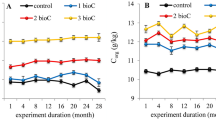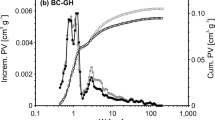Abstract
Black carbon (charcoal, char, soot, biochar) in its raw state can be a strong adsorbent of organic compounds. This chapter reviews and presents new evidence that during weathering in soil, the surface activity of black carbon becomes reduced by deposition of natural organic matter from the surrounding soil matrix on its surfaces. This can rapidly lead to as much as a two-order-of-magnitude decline in the distribution coefficient of the contaminant and a sharp decline in the N2 B.E.T. specific surface area of the black carbon in the mixture. Humic substances suppress sorption by competing for sorption sites and, at cryogenic temperatures, by blocking pore entrances. The competitive effect increases with adsorbate molecular size due to size exclusion (steric) constraints that allow smaller molecules greater access to interior surfaces. It may also increase to the extent adsorbate and humics undergo common interactions with the surface, such as H-bonding. Weathering of black carbon must be taken into accounted in contaminant fate models and in strategies involving the use of black carbon for crop enhancement or soil stabilization.
Access provided by Autonomous University of Puebla. Download conference paper PDF
Similar content being viewed by others
Keywords
Introduction
Black carbon (BC) is an important constituent of the terrestrial carbon pool due to inputs of char, charcoal, and soot from natural fires, land clearing, crop residue burning, and fossil fuel combustion. The “natural” levels of BC in soils and sediments from such sources may comprise several percent of total organic carbon (30% or more in highly affected areas). In addition, BCs produced from biomass wastes, known as biochars, have attracted interest as soil amendments to increase soil fertility and to help stabilize contaminated soil through adsorption.
Depending on feedstock and formation conditions, BC in its fresh (raw) state can be a strong adsorbent of organic compounds owing to its abundant microporosity and the hydrophobic nature of the fundamental structural unit, the polyaromatic sheet. The carbon-normalized distribution coefficient of a compound between raw BC and water (K BC) can be 101–104 times greater than the corresponding value between non-pyrogenic soil organic matter (SOM) and water (K OC) − the difference increasing as solute concentration declines. Even polar and anionic compounds may adsorb strongly to BC (Ni et al. 2011; Teixido et al. 2011).
Thus, BC may impact the sorption of anthropogenic and natural organic compounds in soil or sediment. Although many field studies support this, the contribution of BC to total sorption in a given sample is difficult to evaluate due to (1) the lack of reliable methods for quantifying BC in geosolids, (2) the difficulty of choosing a reference standard to represent BC in the sample because of the intrinsically variable properties of BC, (3) the lack of clarity about which isotherm model to apply to BC and other sample components, and (4) the influence of weathering on the BC material in the soil matrix (Pignatello 2011).
It is this last issue − weathering − that we deal with here. Black carbon is akin to activated carbon in its origin and properties, and it is well known that activated carbon is fouled by humic substances leading to a decline in performance as an adsorbent in water purification applications. We now have abundant evidence that adsorbent ability of BC can be greatly attenuated by weathering in soil due to the deposition of humic substances on its surface.
Results and Discussion
Coating surfaces of BC with humic acid, fulvic acid, or triglycerides as models for SOM lipid components strongly reduced N2 adsorption at 77 K (factor of 10–100) and more modestly reduced CO2 adsorption at 273 K (factor of 3) (Kwon and Pignatello 2005; Pignatello et al. 2006). The addition of dissolved humic or fulvic acid to suspensions of BC in water, or the coating of BC surfaces with aluminum-flocculated humic acid, suppressed adsorption of nonpolar organic compounds in proportion to the compound’s molecular size (e.g., benzene < naphthalene < phenanthrene, and 1,3-dichlorobenzene < phenanthrene) (Pignatello et al. 2006). A number of other groups now have confirmed the inhibitory effect of dissolved humic substances on adsorption to BC. Using stable nitroxyl free radical compounds as C-NMR relaxation probes sorbed to samples of a peat soil and a lignite naturally containing BC, we found that there is little or no preference for interaction spin probe with aromatic over aliphatic regions of the organic matter matrix. This indicates that the BC component of these geosorbents contributes little to sorption.
The effect of weathering on benzene sorption was evaluated in a soil-charcoal-water mixture that was aged for different times at 45°C (Kwon and Pignatello 2005) before adding the benzene. Benzene sorption declined by about 2.3-fold over the month-long weathering period. Over the same period, the N2 B.E.T. surface area of the mixture (but not of the soil-only or charcoal-only controls) declined substantially. If all the changes were attributed to the BC fraction, the decline corresponded to a tenfold reduction in the specific surface area of BC in the mixture.
A similar set of experiments was carried out on the veterinary antibiotic, sulfamethazine, using 1 or 2% (w/w) of each of four commercial biochars mixed with a surface horizon soil and water (Teixido et al. under review). Sulfamethazine is a polar compound (log K OW = 0.27). Yet it sorbed very strongly to three out of four of the raw biochars. The K BC for the raw biochars – depending on sulfamethazine concentration and the biochar – was as much as 105 times greater than the K OC for the tested soil and the mean K OC for 19 soils taken from the literature, about 102 L/kg. Two weathering regimes were employed: 48 h at 20°C (“shorter”) and 28 days at 40°C (“longer”). Sulfamethazine was then added and allowed to equilibrate. The K BC decreased by as much as 102 compared to the K BC of the raw biochar, depending on the biochar and sulfamethazine concentration. The weathering effect was greater in the longer than in the shorter weathering regime yet large even in the shorter regime. The magnitude of the weathering effect increased in proportion to the K BC of the raw char and decreased with biochar amendment level.
A conceptual model for the weathering effect has emerged from these studies based on the fouling effect. Most of the surface area of BC is located in micropores whose apertures are comparable to the widths of small molecules. The model assumes that, due to their size, humic molecules are restricted to the external surfaces where they compete for adsorption sites and/or block entrances to pore networks, which smaller adsorbate molecules otherwise can access. At 77 K, where N2 adsorption is carried out, adsorbed humic molecules are thermally inflexible and therefore greatly restrict the passage of N2 molecules at pore throats to the interior network. Thus, weathering reduces the apparent B.E.T. surface area calculated from the N2 isotherm. At 273 and 293 K, where, respectively, CO2 and organic compound isotherms are normally constructed, adsorbed humic molecules are much more thermally flexible than at 77 K, allowing CO2 and small organic molecules to pass via a cooperative interchange mechanism into the pore networks where humic substances are excluded. Competition with humic substances, thus, exists at the surface but not the interior networks. This explains why CO2 adsorption is only moderately suppressed compared to N2 adsorption. The same mechanism rationalizes the greater sensitivity to competition for larger compared to smaller organic molecules. We found in previous work that adsorbate molecule size is an important factor in adsorption to BC: relative to nonporous graphite as the (unhindered) reference surface, adsorption to BC decreased with the number of substituents on the benzene ring, and with increasing fused ring size (Zhu and Pignatello 2005). Accordingly, smaller molecules (e.g., benzene) have access to more pores than larger molecules (e.g., phenanthrene or sulfamethazine) and are thus less susceptible to competition by humic molecules.
Another potentially important factor controlling the competitive effect is the degree to which the adsorbate and the competing species – in this case humic substances – share interaction mechanisms. Recently, we showed that small weak acids (cinnamic acid, coumaric acid, and sulfamethazine) undergo a type of hydrogen bonding of unusual strength with carboxyl and phenoxyl groups on the black carbon surface that have comparable proton acidities (i.e., pKas) (Ni et al. 2011; Teixido et al. 2011). Since humic substances are abundant in weak acid functional groups (−CO2H, Ar–OH), this may help explain the stronger competition against sulfamethazine compared to benzene.
Weathering is clearly an important factor in the surface activity of black carbon that must be taken into accounted in predictive models of contaminant fate and in strategies involving the use of black carbon for crop enhancement or soil stabilization.
References
Kwon, S., and J.J. Pignatello. 2005. Effect of natural organic substances on the surface and adsorptive properties of environmental black carbon (char): Pseudo pore blockage by model lipid components and its implications for N2-probed surface properties of natural sorbents. Environmental Science and Technology 39: 7932–7939.
Ni, J., J.J. Pignatello, and B. Xing. 2011. Adsorption of aromatic carboxylate ions to charcoal black carbon is accompanied by proton exchange with water. Environmental Science and Technology 45: 9240–9248.
Pignatello, J.J. 2011. Interactions of anthropogenic organic chemicals with natural organic matter and black carbon in environmental particles. In Biophysico-Chemical Processes of Anthropogenic Organic Compounds in Environmental Systems, ed. B. Xing, N. Senesi, and P.M. Huang, 3–50. Hoboken: Wiley.
Pignatello, J.J., S. Kwon, and Y. Lu. 2006. Effect of natural organic substances on the surface and adsorptive properties of environmental black carbon (char): Attenuation of surface activity by humic and fulvic acids. Environmental Science and Technology 40: 7757–7763.
Teixido, M., J.J. Pignatello, J.L. Beltran, M. Grenados, and J. Peccia. 2011. Speciation of the ionizable antibiotic sulfamethazine on black carbon (biochar). Environmental Science and Technology 45: 10020–10027.
Teixido, M., J.J. Pignatello, J.L. Beltran, M. Grenados, J. Peccia. (under review). Predicting contaminant adsorption in biochar-amended soil for the veterinary antimicrobial, sulfamethazine. Environmental Science and Technology.
Zhu, D., and J.J. Pignatello. 2005. Characterization of aromatic compound sorptive interactions with black carbon (charcoal) assisted by graphite as a model. Environmental Science and Technology 39: 2033–2041.
Author information
Authors and Affiliations
Corresponding author
Editor information
Editors and Affiliations
Rights and permissions
Copyright information
© 2013 Zhejiang University Press and Springer Science+Business Media Dordrecht
About this paper
Cite this paper
Pignatello, J.J. (2013). Role of Natural Organic Matter as Sorption Suppressant in Soil. In: Xu, J., Wu, J., He, Y. (eds) Functions of Natural Organic Matter in Changing Environment. Springer, Dordrecht. https://doi.org/10.1007/978-94-007-5634-2_91
Download citation
DOI: https://doi.org/10.1007/978-94-007-5634-2_91
Published:
Publisher Name: Springer, Dordrecht
Print ISBN: 978-94-007-5633-5
Online ISBN: 978-94-007-5634-2
eBook Packages: Earth and Environmental ScienceEarth and Environmental Science (R0)




